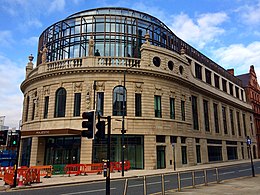
The Leeds Corn Exchange is a shopping mall in Leeds, West Yorkshire, England. The structure, which was commissioned as a corn exchange, is a grade I listed building.

City Square is a paved area north of Leeds railway station at the junction of Park Row to the east and Wellington Street to the south. It is a triangular area where six roads meet: Infirmary Street and Park Row to the north, Boar Lane and Bishopsgate Street to the south-east, and Quebec Street and Wellington Street to the south-west. The only building with a direct frontage is the former General Post Office, on the north-west side.

Bolton and Undercliffe is an electoral ward in the City of Bradford Metropolitan District Council, England. The population of the ward at the 2011 Census was 16,365. Bolton and Undercliffe covers the area east of Bradford Beck, between Shipley & Wrose to the north and central Bradford to the south. It is a largely urban area.

Gatecrasher One was a nightclub in Sheffield, South Yorkshire, England. The club was a converted warehouse owned by the Gatecrasher dance music brand. The nightclub was originally named The Republic, but this was changed in 2003 after a £1.5 million refurbishment. On 18 June 2007 the venue caught fire and partially collapsed. The building was later demolished.
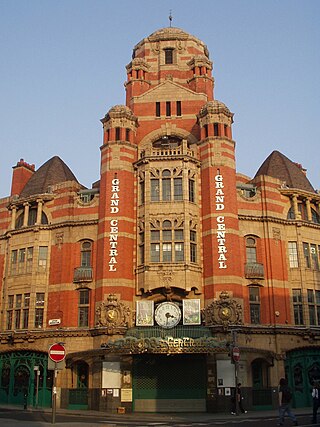
The Grand Central Hall is on 35 Renshaw Street, Liverpool, England. It is now the site of the Liverpool Grand Central Hotel, Hall and Grand Bazaar Food Hall. The building is recorded in the National Heritage List for England as a designated Grade II listed building.

The Light is a leisure and retail centre in central Leeds in West Yorkshire, England. It occupies the rectangular space between The Headrow on the south, St Anne's Street on the north, Cookridge Street on the west, and Albion Street. Two former streets divide it: Upper Fountaine Street (east-west) and Cross Fountaine Street (north-south) now covered with a glass roof. It incorporates two listed buildings Permanent House and the Headrow Buildings.

Leeds Town Hall is a 19th-century municipal building on The Headrow, Leeds, West Yorkshire, England. Planned to include law courts, a council chamber, offices, a public hall, and a suite of ceremonial rooms, it was built between 1853 and 1858 to a design by the architect Cuthbert Brodrick. With the building of the Civic Hall in 1933, some of these functions were relocated, and after the construction of the Leeds Combined Court Centre in 1993, the Town Hall now serves mainly as a concert, conference and wedding venue, its offices still used by some council departments. It was designated a Grade I listed building in 1951.

Leeds City Museum, originally established in 1819, reopened in 2008 in Leeds, West Yorkshire, England. It is housed in the former Mechanics' Institute built by Cuthbert Brodrick, in Cookridge Street. It is one of nine sites in the Leeds Museums & Galleries group.

The O2 Academy Leeds (formerly known as the Town and Country Club) is a music venue situated in Leeds, West Yorkshire, England. It is run by the Academy Music Group, which has other music venues around the UK. The Academy was nominated for the TPi Awards 2010 for the country's favourite venue.

The Hyde Park Picture House is a cinema and Grade II listed building in the Hyde Park area of Leeds, West Yorkshire, England. Built by Thomas Winn & Sons, it opened on 7 November 1914. It features many original features, such as an ornate balcony and external box office, and is believed to be the only remaining gaslit cinema in the world. Following the installation of "comfier seating", the Picture House has a capacity of 275, down from around 587 on opening.
The Odeon Haymarket was a cinema on Haymarket, London. Three cinemas occupied the site between 1925 and 1996, predecessors being Capitol Cinema (1925–1936) and Gaumont Haymarket (1937–1959). It became the Odeon Haymarket in 1962, before closing in 1996.

Chapel Allerton is an inner suburb of north-east Leeds, West Yorkshire, England, 2 miles (3.2 km) from the city centre.

In 1898 William Morton's Theatre Royal showed a 'Veriscope' film, probably the first time any film was shown in a Hull theatre. The Prince's Hall was the first purpose-built cinema in Kingston upon Hull, and was opened in George Street by Morton in 1910. As Hull embraced the new age of public entertainment, attendances at traditional theatre declined. Luxurious cinemas, taking their inspiration from theatres and music halls, were built to accommodate audiences in almost every neighbourhood in the city. By 1914, there were 29 cinemas, theatres and halls showing films in the city. The London and Provincial Cinema Company owned the Hippodrome; the National Electric Picture Theatres owned the Theatre de Luxe, but Morton's was the largest and most influential cinema chain in Hull.

John Stanley Coombe Beard FRIBA, known professionally as J. Stanley Beard, was an English architect known for designing many cinemas in and around London.
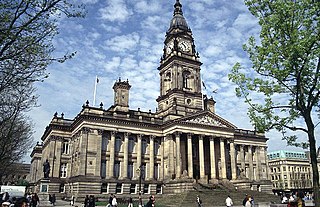
Bolton Town Hall in Victoria Square, Bolton, Greater Manchester, England, was built between 1866 and 1873 for the County Borough of Bolton to designs by William Hill of Leeds and George Woodhouse of Bolton. The town hall was extended in the 1930s to the designs of Bradshaw, Gass and Hope and has been designated a Grade II* listed building by English Heritage.
Bradford Odeon is the name applied to two different cinemas in central Bradford, West Yorkshire, England. One, in Godwin Street, was built in 1930 and survives; the other, in Manchester Road, was built in 1938 and demolished in 1969.

The Embassy Cinema is a former cinema in the town of Chadwell Heath, Greater London. It was once known, among locals, as The Gaumont. It was designed in an art deco style, with a streamline moderne interior, by Harry Weston in 1934. The building is situated on the border of Redbridge and Barking & Dagenham, in the Chadwell Heath District Centre. The cinema closed in 1966 and became a Bingo Hall. In 2015, following the closure of the Bingo Hall, it was then used as a wedding hall/banqueting suite. The building was listed as an Asset of Community Value by the 'Chadwell Heath South Residents' Association' in August 2017 and is currently the focus of a major cinema restoration project.
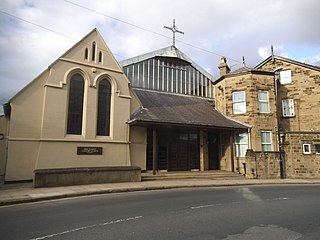
St Joseph's Church is an active Roman Catholic church in Wetherby, West Yorkshire, England.
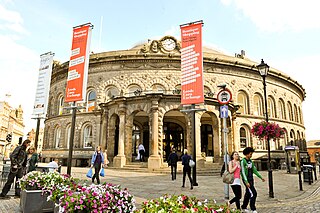
Rushbond plc is an unlisted commercial and residential property development and investment company in the United Kingdom. It was founded in Leeds, West Yorkshire in 1986 by Jonathan W Maud and exclusively operates around the Leeds City Region, into which it invested £14.3 million in 2019. The company, though specialising in the conversion and redevelopment of listed heritage buildings, also engages in the construction of new-build property and acquisitions.
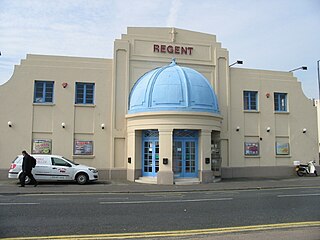
The Regent Cinema is a former cinema and bingo hall in Deal, Kent, England. It was originally built in 1928 as a simple pavilion for musical concerts but this proved unprofitable and in 1933 it was converted into a cinema, with an Art Deco-style entrance. The cinema closed in 1963 and was briefly used as a wrestling venue before being converted into a bingo hall. The bingo hall closed in 2009 and the site has lain derelict since then.
